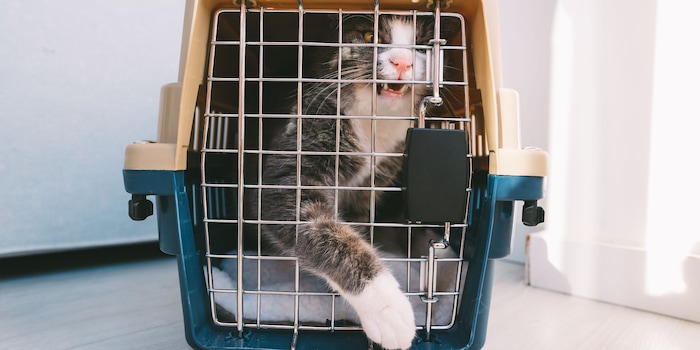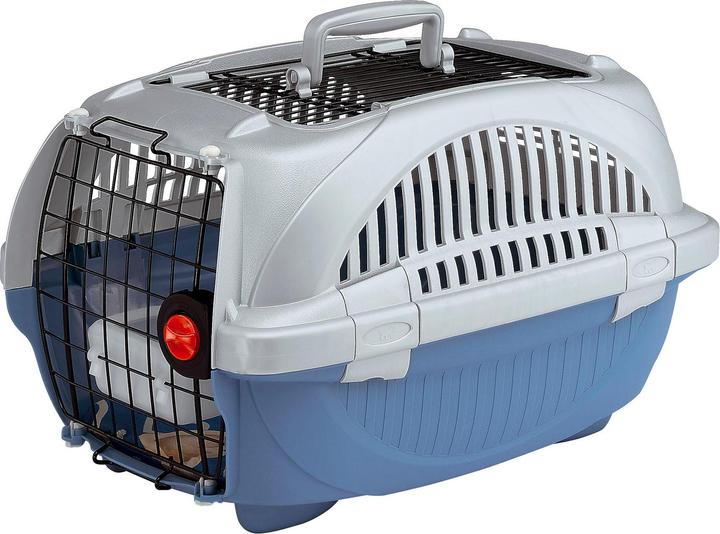

How to transport your cat to the vet fuss-free
It’s always the same story: it’s time to go to the vet, but your cat categorically refuses to go in the carrier. Here are five tips – tried and tested by an expert.
I see it as if it was yesterday: my mum, my childhood cat Léonie and the struggle to get her in the carrier, both pushing with all their might – my mum in an effort to get Léonie in, Léonie in an effort to stay out. Most of the time, my mum was victorious. Though it was a short-lived victory which ended once we were sat in the car, Léonie belting out a one-cat opera.
Does using a carrier really have to be such a struggle? Cats love to squeeze into the smallest of boxes. As we’ve seen on social media, «If it fits, I sits.» To get to the bottom of this dilemma, I scoured the internet for tips and consulted animal psychologist Dominique Gloor for confirmation.

Source: Giphy
1. The right carrier
What you should look out for when choosing a carrier is the size, opening and material. The carrier should be long enough for your cat to lie down comfortably. Having two openings are advantageous – one at the front and one at the top. The latter should make it especially easy to get your kitty in and out. On the other hand, wicker cat carriers are typically not recommended, because your cat’s claws can get caught in them and they’re difficult to clean.



Ferplast Transport box Atlas Deluxe open
Cat, Can be opened completely
2. The acclimatisation
If your cat sees the transport box only once or twice a year, its mistrust and therefore reluctance to get in may be great, especially if your cat has had negative experiences with it before. To prevent this, it’s best to place the transport box in your living room or another place where your cat spends a lot of time. The goal? You want your cat to start using the carrier for sleeping. Place your furball’s favourite blanket or treats inside, or spread some catnip to entice them to enter. If they approach the box, go inside or lie down in it, reward them. Clicker training (linked article in German) may prove useful.
3. The carrying
Even if your kitty accepts the transport box, they’re unlikely to go in right when you’d need them to. That’s something you’ll have to make happen. So, get them used to being carried around – preferably a few weeks or months before the vet appointment. How? Keep picking them up briefly and rewarding them. If they want to be put down, do so. If your feline keeps resisting after multiple attempts, leave it be. Especially with a rescue cat, you don’t know what they’ve been through.
4. The day before
To spare your cat as much stress as possible and prevent them from panicking and running away at the worst moment, it’s best to have everything you need ready the day before the vet visit. If necessary, you can also use pillows to block your kitty’s favourite hiding places and close doors so you don’t have to hunt for them under the couch or bed under pressure.
5. Showtime
The vet visit is imminent and you’ve implemented all of the above tips? Then I’ve got one final tip for you: relax. I know, I know – that’s rich when you’re at your last straw. But the more stressed you get, the more stressed your cat gets. So, try to take a deep breath and talk to them calmly. You can also use a calming cat spray if necessary.
Of course, despite all attempts, your cat may still refuse to sit in the carrier. Perhaps they’ve experienced too many failed tries. If so, it may be worth buying a new box that’s totally different from the previous one. And then you take it from the top.

Source: Shutterstock
How easy is your cat to transport? What tips do you have for other pet owners?
Header image: Shutterstock
I love anything with four legs or roots - especially my shelter cats Jasper and Joy and my collection of succulents. My favourite things to do are stalking around with police dogs and cat coiffeurs on reportages or letting sensitive stories flourish in garden brockis and Japanese gardens.
Practical solutions for everyday problems with technology, household hacks and much more.
Show all





